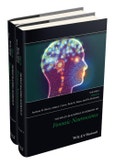Explores how the explosion of neuroscience-based evidence in recent years has led to a fundamental change in how forensic psychology can inform working with criminal populations.
This book communicates knowledge and research findings in the neurobiological field to those who work with offenders and those who design policy for offender rehabilitation and criminal justice systems, so that practice and policy can be neurobiologically informed, and research can be enhanced.
Starting with an introduction to the subject of neuroscience and forensic settings, The Wiley Blackwell Handbook of Forensic Neuroscience then offers in-depth and enlightening coverage of the neurobiology of sex and sexual attraction, aggressive behavior, and emotion regulation; the neurobiological bases to risk factors for offending such as genetics, developmental, alcohol and drugs, and mental disorders; and the neurobiology of offending, including psychopathy, antisocial personality disorders, and violent and sexual offending. The book also covers rehabilitation techniques such as brain scanning, brain-based therapy for adolescents, and compassion-focused therapy.
The book itself:
- Covers a wide array of neuroscience research
- Chapters by renowned neuroscientists and criminal justice experts
- Topics covered include the neurobiology of aggressive behavior, the neuroscience of deception, genetic contributions to psychopathy, and neuroimaging-guided treatment
- Offers conclusions for practitioners and future directions for the field.
The Handbook of Forensic Neuroscience is a welcome book for all researchers, practitioners, and postgraduate students involved with forensic psychology, neuroscience, law, and criminology.
Table of Contents
VOLUME 1
About the Editors xi
List of Contributors xiii
Part I Introduction 1
1 Neuroscience in Forensic Settings: Origins and Recent Developments 3
Anthony R. Beech and Dawn Fisher
2 A Brief Introduction to Neuroscience 25
Pia Rotshtein and Ian J. Mitchell
Part II General Neuroscience Research 59
3 The Neurobiology of Aggressive Behavior 61
Jens Foell and Christopher J. Patrick
4 The Neurobiology of Sexual Behavior and Sexual Attraction 83
Anders Agmo
5 Reward Sensitivity and Behavioral Control: Neuroimaging Evidence for Brain Systems Underlying Risk-Taking Behavior 105
Renate L. E. P. Reniers, Ulrik R. Beierholm, and Stephen J. Wood
6 The Neurobiology of Emotion Regulation 125
Catherine L. Sebastian and Saz P. Ahmed
7 The Social Neuroscience of Empathy and its Relationship to Moral Behavior 145
Jean Decety and Jason M. Cowell
8 The Neuroscience of Deception 171
Jennifer M. C. Vendemia and James M. Nye
Part III Neurobiology of Offending 189
9 The Neurobiological Underpinnings of Psychopathy 191
Stephane A. De Brito and Ian J. Mitchell
10 Antisocial Personality Disorder 229
Sheilagh Hodgins, Dave Checknita, Philip Lindner, Boris Schiffer, and Stephane A. De Brito
11 Offenders with Autism Spectrum Disorder 273
Bjorn Hofvander
12 The Neuroscience of Violent Offending 301
Heather L. McLernon, Jeremy A. Feiger, Gianni G. Geraci, Gabriel Marmolejo, Alexander J. Roberts, and Robert A. Schug
13 The Neuroscience of Sexual Offending 333
Andreas Mokros
14 The Neuroscience of Acquisitive/Impulsive Offending 359
Claire Nee and Stephanos Ioannou
15 Neurobiology of Brain Injury and its Link with Violence and Extreme Single and Multiple Homicides 385
Clare S. Allely
16 The Neurobiology of Offending Behavior in Adolescence 421
Graeme Fairchild and Areti Smaragdi
17 Alcohol-Related Aggression and Violence 455
Stefan Gutwinski, Adrienne J. Heinz, and Andreas Heinz
VOLUME 2
About the Editors xi
List of Contributors xiii
Part IV Neurobiological Bases to Risk Factors for Offending 481
18 Genetic Contributions to the Development of Psychopathic Traits and Antisocial Behavior in Youths 483
Nathalie M. G. Fontaine, Eamon J. McCrory, and Essi Viding
19 Developmental Risk Factors 507
Anthony R. Beech, Ben Nordstrom, and Adrian Raine
20 Mental Illness as a Putative Risk Factor for Violence and Aggression 531
Ahmad Abu-Akel and Sune Bo
21 Modifying Risk Factors: Building Strengths 553
Corine de Ruiter
Part V Rehabilitation 575
22 Engaging with Forensic Populations: A Biologically Informed Approach 577
Fiona Williams and Adam J. Carter
23 Brain Scanning and Therapeutics: How Do You Know Unless You Look? Neuroimaging Guided Treatment in Forensic Settings 601
Daniel G. Amen and Kristen Willeumier
24 Therapy for Acquired Brain Injury 631
Nick Alderman, Caroline Knight, Jennifer Brooks
25 The Impact of Physical Exercise on Antisocial Behavior: A Neurocognitive Perspective 659
Dylan B. Jackson and Kevin M. Beaver
26 Treating Emotion Dysregulation in Antisocial Behavior: A Neuroscientific Perspective 677
Steven M. Gillespie and Anthony R. Beech
27 The Pharmacological Treatment of Sex Offenders 703
Don Grubin
28 Understanding and Using Compassion-Focused Therapy in Forensic Settings 725
Russell Kolts and Paul Gilbert
29 The Neurobiology of Eye Movement Desensitization Reprocessing Therapy 755
Derek Farrell
30 Adjusting the Lens: A Developmental Perspective for Treating Youth with Sexual Behavior Problems 783
Kevin Creeden
Part VI Ethical, Legal, and Political Implications 813
31 The Impact of Neglect, Trauma, and Maltreatment on Neurodevelopment: Implications for Juvenile Justice Practice, Programs, and Policy 815
Bruce D. Perry, Gene Griffin, George Davis, Jay A. Perry, and Robert D. Perry
32 Forensic Neuropsychology and Violence: Neuroscientific and Legal Implications 837
John Matthew Fabian
33 Forensic Neuropsychology in the Criminal Court: A Socio-legal Perspective 889
Leon McRae
34 Forensic Neuropsychology: Social, Cultural, and Political Implications 917
Jessica Pykett
Part VII Conclusions 937
35 Explanation in Forensic Neuroscience 939
Tony Ward and Carolyn E. Wilshire
36 Considerations for the Forensic Practitioner 947
Adam J. Carter and Ruth E. Mann
Index 959







